Resistance band colors may look pretty, but what do they actually mean?! This post explains the relationship between resistance band color and weight.
Resistance band color and weight is specified by each manufacturer. Generally speaking, blue and yellow are often used to represent weights of up to 20lbs whilst red and black are often used to represent weights up to 50lbs. But this can vary from company to company.
I started using resistance bands 5 years ago.
And the different color code systems utilized by each company left me confused about what resistance levels I was actually buying.
Below, I guide you through the meaning behind the different resistance band colors and weights, and how to choose the right one for your fitness levels.
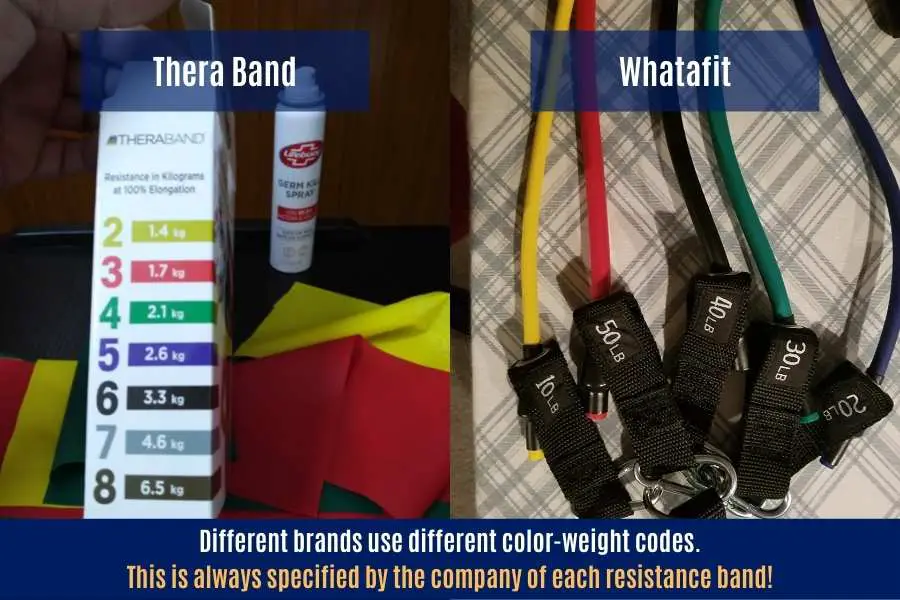
- Are All Resistance Band Colors The Same?
- What Each Resistance Band Color Means
- Which Color Resistance Bands Have The Strongest And Weakest Weight
- Are Resistance Band Colors Universal?
- What The Weight Means On Each Resistance Band Color
- How Beginners Should Use Different Resistance Band Colors
- How To Choose The Right Resistance Band Color And Weight
- Conclusion
Are All Resistance Band Colors The Same?
Resistance band colors are not all the same. Different colors represent different weights and different brands use unique color codes to differentiate the tension levels for each band. Heavier bands are more suitable for working larger muscle groups compared to lighter bands.
Yup.
The color of a resistance band isn’t just there for aesthetic purposes.
It’s there to allow you to easily identify how heavy a particular band actually is.
Therefore resistance band colors are NOT all the same.
Each resistance band’s color distinguishes how much force it exerts on the user.
More specifically, which ones exert the most force and which ones exert the least force.
The heavier the resistance band the harder it is to push or pull on it and the more intense the workout (and vice versa).
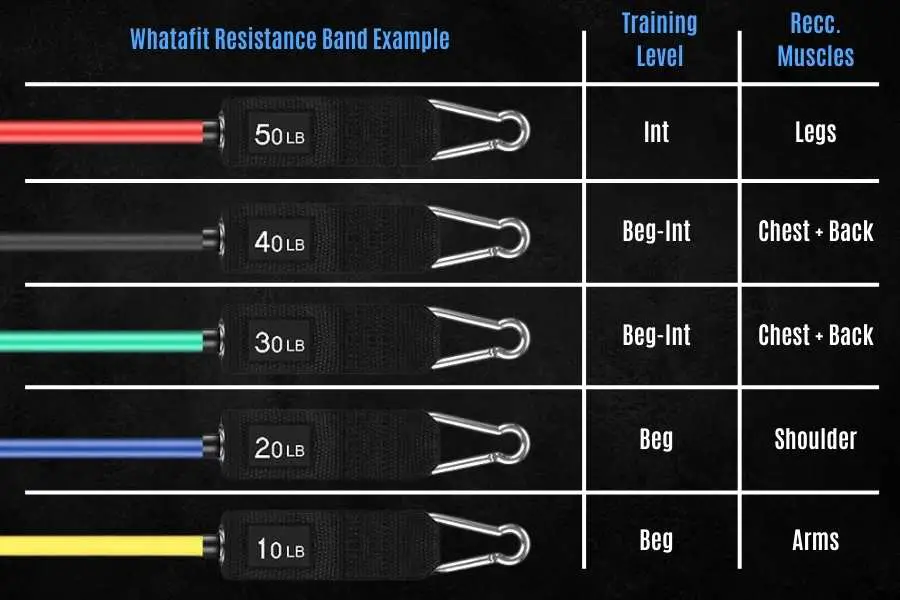
Now, the company could make their bands all the same color (and some brands actually do that).
But the issue there is that it can become difficult to visually differentiate the bands based on thickness alone, especially during intense workouts.
This is why resistance band companies color code their resistance bands for easy identification.
What Each Resistance Band Color Means
Coloring denotes the amount of tension each resistance band provides. Manufacturers assign different colors to different resistance levels according to their own color-coding system. Commonly used colors include gold, silver, red, yellow, blue, green, and black. But other colors can also be used.
You can check out the color-code guide charts below for a better idea of tension levels typically used by different resistance bands.
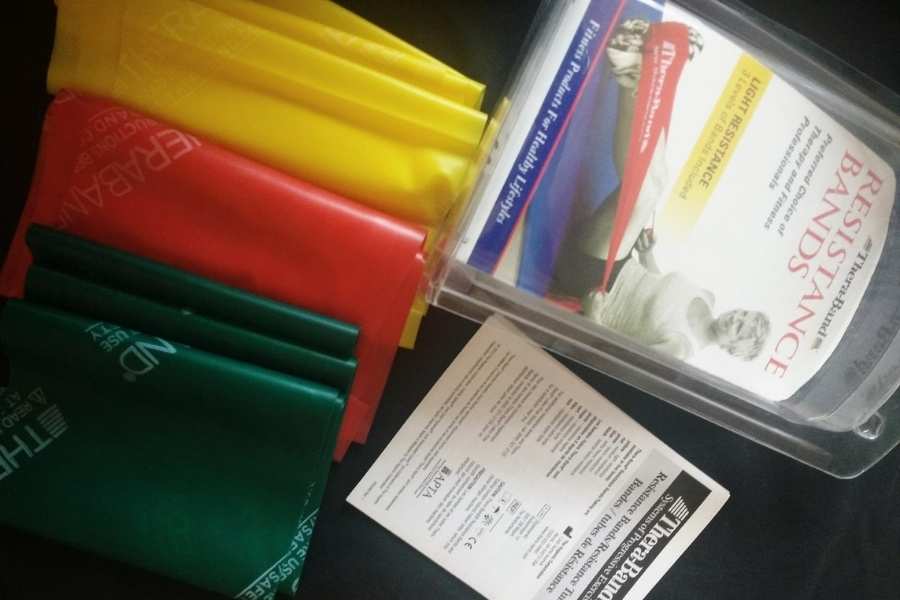
Here’s the color code used by the highly reputable Thera resistance bands company:
| Resistance Band Color | Tension Level | Weight Classification | Good For: |
|---|---|---|---|
| Tan | 2.4lbs | Extremely light | Post-injury rehabilitation and stretching. |
| Yellow | 3.0lbs | Extra light | Post-injury rehabilitation and stretching. |
| Red | 3.7lbs | Light | Arm exercises at a novice level. |
| Green | 4.6lbs | Light-moderate | Arm exercises at a novice level. |
| Blue | 5.8lbs | Moderate | Shoulder exercises at a novice level. |
| Black | 7.3lbs | Heavy moderate | Chest and back exercises at a novice level. |
| Silver | 10.2lbs | Heavy | Chest and back exercises at a novice level. |
| Gold | 14.2lbs | Extra-heavy | Leg exercises at a novice level. |
These resistance bands are considered to be light by most standards and even the heaviest color provides a relatively low tension compared to other brands on the market.
As such, these resistance bands are perfect for the beginner.
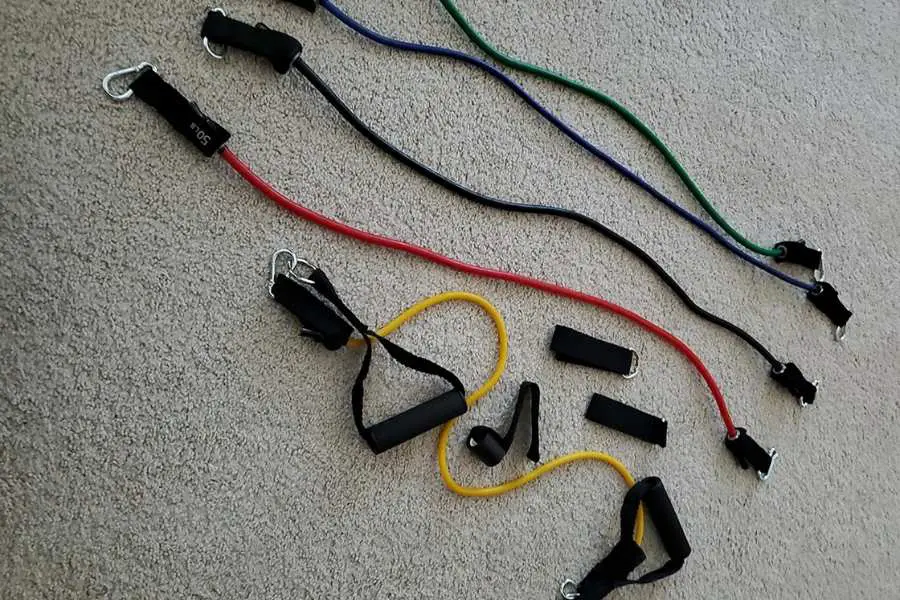
Now, compare this with the color code used by Whatafit resistance bands:
| Resistance Band Color | Tension Level | Weight Classification | Good For: |
|---|---|---|---|
| Yellow | 10lbs | Extra-light | Arm exercises at a beginner-intermediate level. |
| Blue | 20lbs | Light | Shoulder exercises at a beginner-intermediate level. |
| Green | 30lbs | Moderate | Chest and back exercises at a beginner-intermediate level. |
| Black | 40lbs | Heavy | Chest and back exercises at a beginner-intermediate level. |
| Red | 50lbs | Extra-heavy | Leg exercises Chest and back exercises at a beginner-intermediate level. |
These provide more resistance and they are ideal for intermediates.
Which Color Resistance Bands Have The Strongest And Weakest Weight
The strongest and weakest tension colors vary depending on the resistance band manufacturer. With that being said, however, black and red resistance bands commonly provide the most difficult tension levels. In comparison, yellow and blue bands often provide the easiest tension levels.
Whilst the color-resistance coding varies amongst manufacturers, all resistance bands have one thing in common; they come with a color-coding chart.
This is simply a legend that specifies which band color provides what resistance levels.
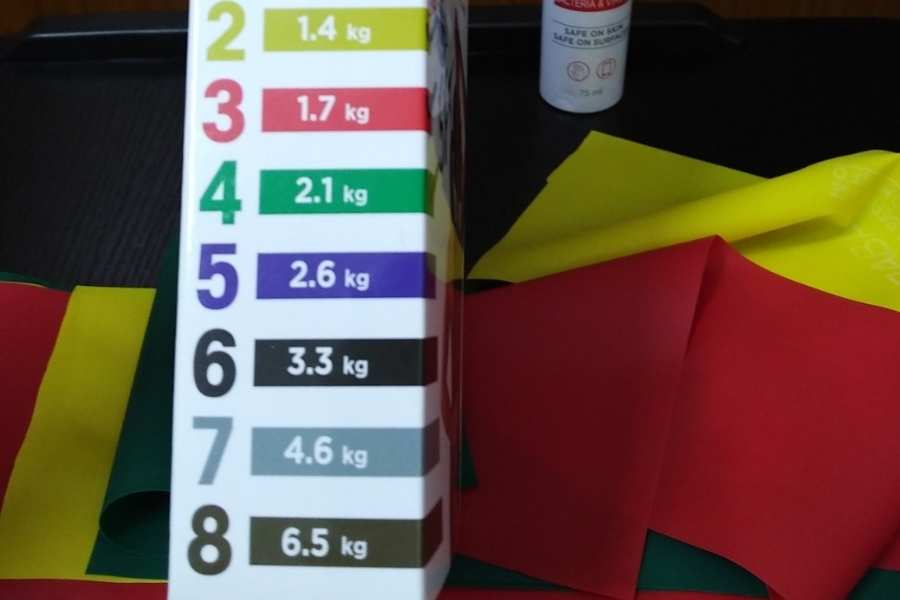
Take a look at the Thera band color chart above.
You can see that the yellow-colored band provides the weakest and easiest resistance, whilst the gold-colored band provides the strongest and hardest resistance.
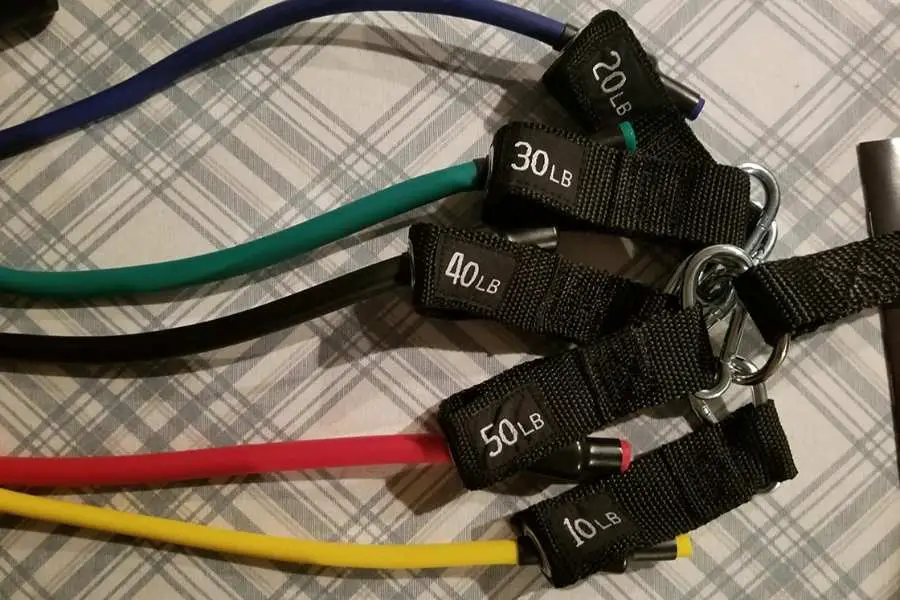
Now take a look at the Whatfit color chart above.
Here, you can see that the yellow-colored band provides the weakest and easiest resistance, whilst the red-colored band provides the strongest and hardest resistance.
Therefore it’s impossible to accurately say which color band is the hardest or easiest to use since different companies use different color coding systems.
Are Resistance Band Colors Universal?
I’ve already established that different brands utilize different color codes for their resistance brands.
Therefore resistance band colors are NOT universal.
However, what IS universal is that all bands utilize some kind of weight coding system.
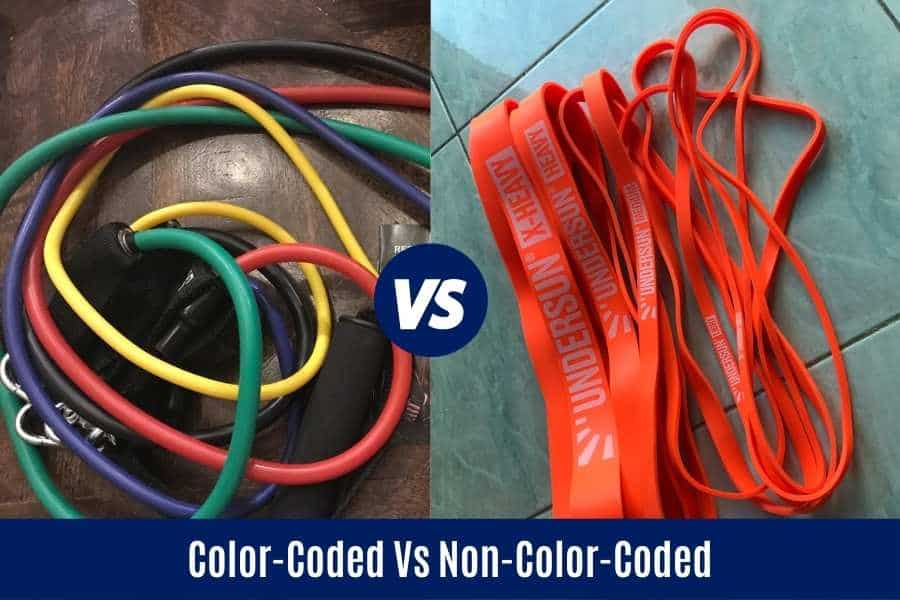
Color coding (as explained in the above sections) is just one way that companies use to differentiate the resistance levels on their bands.
Other companies utilize non-color coding, where each band is the same color as each other but labeled with their respective resistance levels.
I personally find this to be more aesthetically pleasing, but it’s down to personal preference at the end of the day.
It should be noted, however, that bands that use non-color coding generally provide the highest resistance levels.
As such, these bands are often the best for advanced lifters and those looking to build muscle.
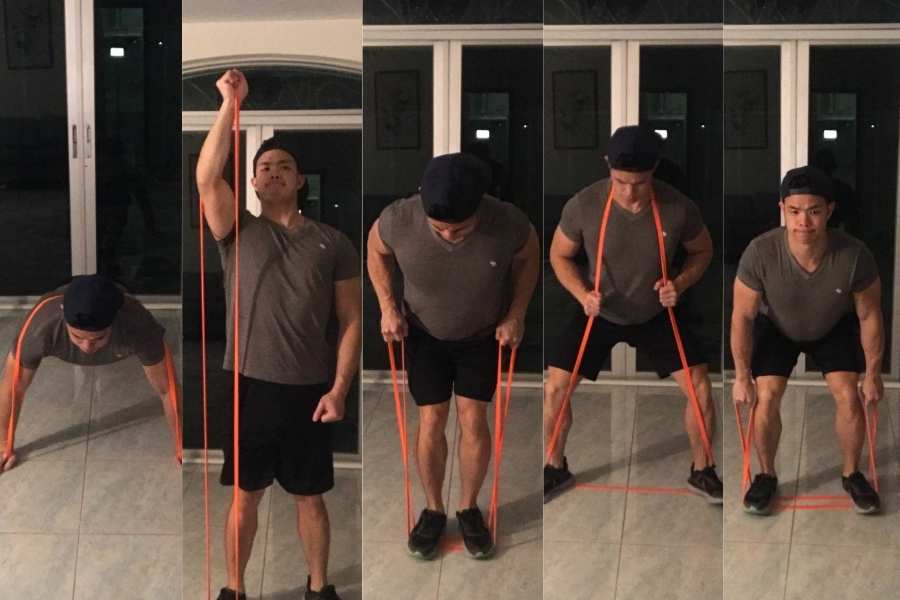
The Undersun bands (link for my review) are a good example of this type of resistance band.
I’ve been using for 3 years now and highly recommend them.
I like these resistance bands because they are durable (come with a lifetime warranty unlike cheap brands that snap), the weight coding is easy to read, and they provide enough weight for beginners and advanced lifters alike.
What The Weight Means On Each Resistance Band Color
The weight on each band indicates the total amount of resistance it provides. This is usually given as lbs and represents the maximum tension that a band can provide in a fully-stretched state. Resistance increases as bands stretch from the resting state.
If you think of a resistance band as a giant elastic band, you can imagine how tension increases as the band stretch.
The point of maximum stretch (usually about 2-3 times the resting length) is when the band gives you the most resistance.
This is what the weight indicates on each band.
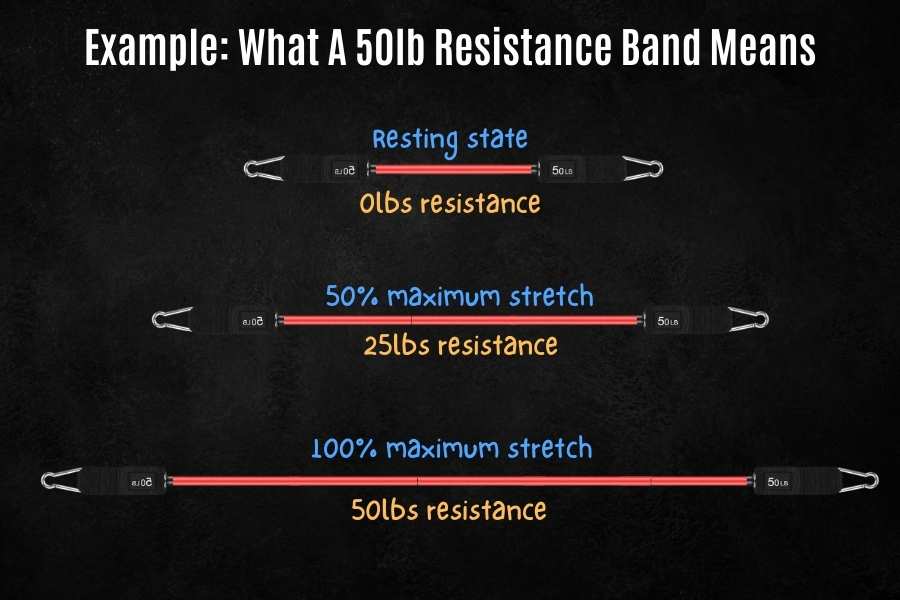
So if resistance is quoted to 50lbs, then this means the band gives you 50lbs of resistance when fully stretched.
If the same band were to be stretched to half its maximum length, then it would provide you with around 25lbs of resistance.
If you are interested, you can check out my other article on how resistance bands work and why they are so effective.
How Beginners Should Use Different Resistance Band Colors
Light band colors are ideal for small exercises like bicep curls, whilst heavier band colors work well for the big lifts like the resistance band press.
Generally speaking, beginners should work with the easier resistance band colors and progress onto the harder colors as they become stronger.
You know you’ve found the ideal resistance band color when the 8-15 reps are challenging for that exercise.
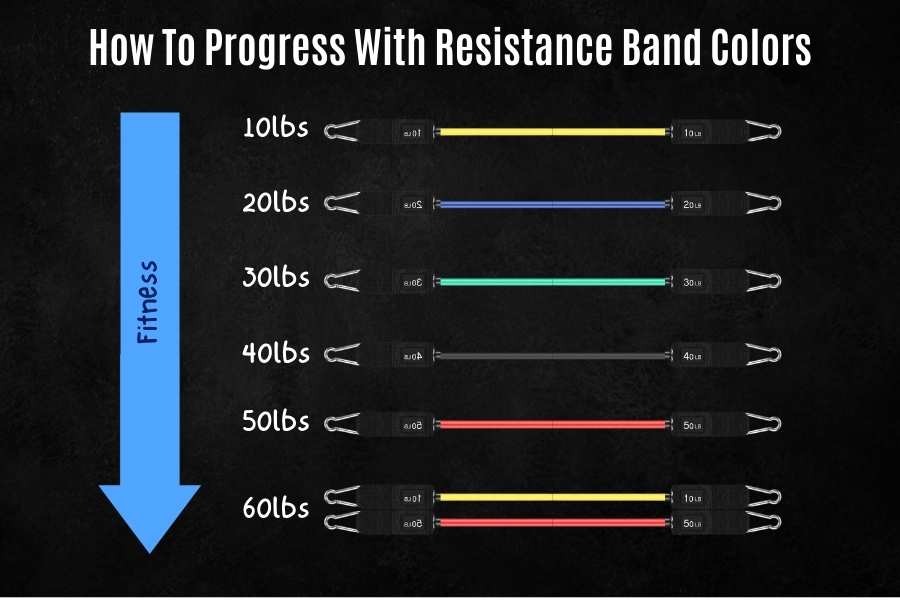
If the resistance band isn’t challenging enough then upgrade to a heavier band.
And if it’s too challenging then downgrade to a lighter band.
Additionally, it’s not uncommon for people to outgrow the individual bands (especially on the big movements like squats, presses, and rows).
If and when you reach this stage, you can combine different band colors to create even heavier resistance levels!
To learn about the types of results you can achieve using bands, you can check out my other post for resistance bands before and after transformations!
How To Choose The Right Resistance Band Color And Weight
The great thing about bands is that they’re relatively safe.
This means you can use trial and error to experiment with the ideal resistance band color for your fitness levels.
As I mentioned above, you should choose a weight that challenges you for 8-15 reps.
This simply means your muscles should feel fatigued by the 8th-15th rep.
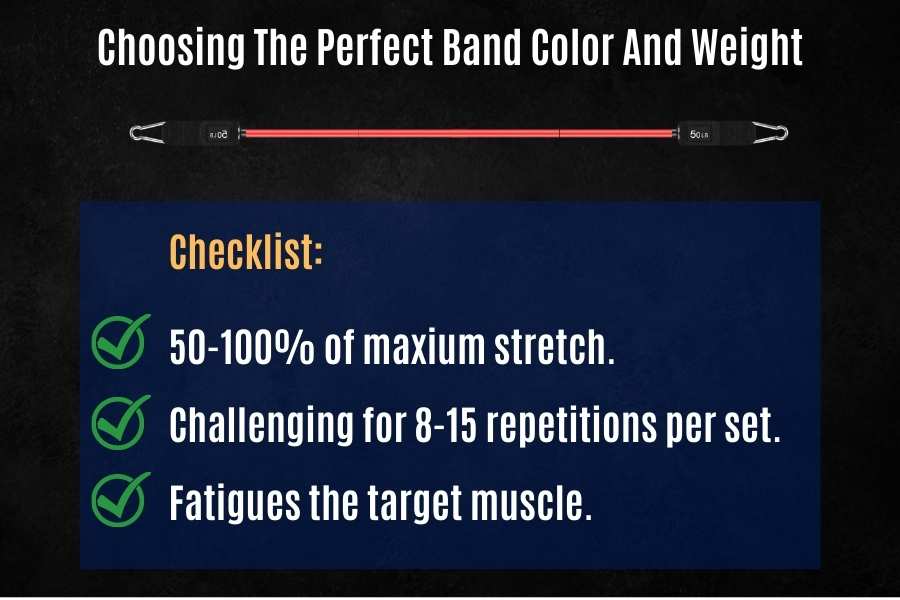
When you’re experimenting with different resistance band colors, it’s important not to over-stretch them.
It can be tempting to use a lighter weight and stretch them more than 2-3 times their resting length to get a good tension.
However, this should be avoided since resistance bands can snap and break.
Instead, you should choose a resistance band color that has a suitable weight within the 2-3x stretch limit.
If you’re using resistance bands for pull-up assistance, you might want to check out my other post on choosing the ideal band length and weight for pull-ups.
Conclusion
I’ve shared a beginner’s guide on what resistance band color is and what weight.
Every company utilizes a different coding system where different colors represent different weights.
Common colors for light resistance bands include blue and yellow, whilst popular colors for heavy resistance bands include red and black.
But this will vary from company to company.
Universally speaking, each brand will specify how much resistance each of its bands provides.
And this weight indicates the level of tension a band provides in its stretched form.
What color and weight are your resistance bands?
Feel free to send me a message if you have any questions! You can find my details on the “contact us” page.
You may also be interested in the downloadable Kalibre Blueprint PDF which details exactly how I gained 40lbs of lean muscle (it’s 100% free!). It details the exact exercises and nutrition (with printable worksheets) I used to go from skinny to ripped!
Thanks for reading guys!
Peace Out,
Kal
(Biochemistry BSc, Biomedical Sciences MSc, Ex-Skinny Guy)


